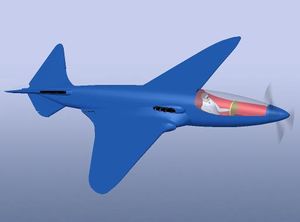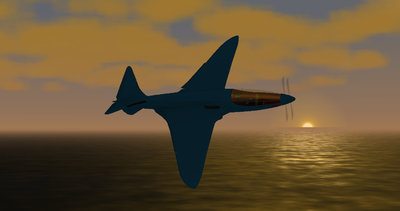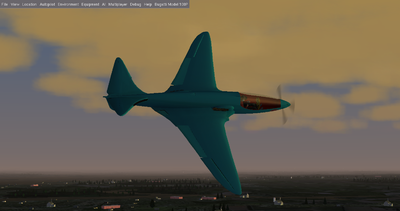Bugatti 100P
(Redirected from Bugatti 100)
Jump to navigation
Jump to search
 | |
|---|---|
 | |
| Type | Racing aircraft, Historical aircraft |
| Configuration | Low wing aircraft |
| Propulsion | Piston aircraft, Single-engine aircraft |
| Manufacturer | Bugatti |
| Author(s) |
|
| FDM | YASim |
| --aircraft= | bugatti |
| Status | Beta |
| FDM |
|
| Systems |
|
| Cockpit |
|
| Model |
|
| Development | |
| Hangar |
|
| Website |
|
| Repository |
|
| Download |
|
| License | GPLv2+ |
|
| |
Tragically the Bugatti 100P airplane never flew, the Germans invaded Paris before it was 100% ready. The airplane surprisingly survived the war, and still exists. The airplane is now in the EAA museum in Oshkosh, USA. Both engines exist, and were built into Bugatti race-cars.


1600 by 1200 wallpaper with the Bugatti (from here)
Some of the airplane´s characteristics:
- Extremely streamlined design, made possible by placing the two engines behind the cockpit.
- Forward swept wings
- A sandwich-construction in wood, where balsa wood between two layers of hard wood makes a very light, very strong and stiff construction.
- Propulsion by two counter-rotating propellers, driven from the two engines by axles under the pilot´s elbow.
- The airplane was equipped with ground adjustable propellers. Propellers with in-flight adjustable pitch were being developed
- The engines were special developments of racecar engines, 8 cylinder 4.9 litre with compressor and many magnesium parts, approx. 450hp.
- Automatic wing-flaps, that changed the wingprofile for extra lift or less drag. Adjustment automatic according to airspeed, throttle etc.
- This system was also capable of acting as an airbrake, or be used during dives. The same system also automatically lowered and raised the retractable landing gear.
- Special cooling system with radiators in the fuselage, air entering at the leading edge of the stabilisers. The air flowed through the fuselage to the front, exiting at the trailing edge of the wing.
- "Y" tail.
